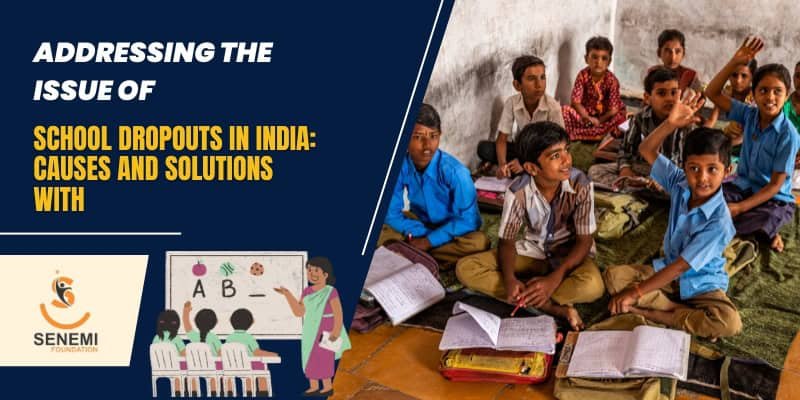

Introduction
India's journey toward becoming a developed nation is intricately tied to the quality and inclusiveness of its education system. However, the alarming rate of school dropouts presents a significant hurdle. According to UNICEF and various national surveys, millions of children drop out of school each year due to socioeconomic, cultural, and systemic issues. This blog explores the causes and solutions for school dropouts in India and highlights how Senemi's innovative educational programs can transform the lives of dropout students, fostering a pathway toward holistic development.
Understanding the Causes of School Dropouts in India
1. Economic Challenges
Child Labour
One of the most significant contributors to school dropouts in India is child labour. Families struggling with poverty often rely on their children’s earnings to make ends meet. As a result, children are forced to leave school and work in industries like agriculture, domestic services, or small-scale enterprises. The need for immediate financial support overshadows the long-term benefits of education.
Cost of Education
Despite government initiatives to provide free education, the ancillary costs of schooling—such as uniforms, books, stationery, and transportation—create financial strain on families. This additional burden compels many parents to withdraw their children from schools, especially in low-income households.
2. Social and Cultural Norms
Child Marriages
Cultural practices and economic pressures often result in early marriages, particularly for girls. Once married, young girls are typically expected to take on household responsibilities, leaving little to no opportunity for continuing their education. This issue is more prevalent in rural areas, where traditional norms outweigh the emphasis on girls’ education.
Gender Discrimination
Gender bias remains a persistent issue in Indian society. Families often prioritize boys' education over girls', perceiving the former as a better investment for the future. Girls are frequently burdened with domestic chores, further hindering their ability to attend school and excel academically.
3. Poor Quality of Education
Lack of Relevance
Many students find the curriculum outdated and irrelevant to their everyday lives. The lack of engaging, real-world connections in the teaching material results in a loss of interest among students, eventually leading to dropouts.
Insufficient Resources
Overcrowded classrooms, a shortage of trained teachers, and inadequate infrastructure are common in many schools across India. These deficiencies create an uninspiring and challenging learning environment, making students more likely to discontinue their education.
4. Health and Nutrition Issues
Impact of Malnutrition
Malnutrition significantly affects children’s cognitive abilities and physical health, leading to irregular attendance and poor academic performance. Many children, particularly in underprivileged communities, struggle to keep up with their peers due to hunger and related health issues.
Menstrual Hygiene
For adolescent girls, the lack of proper menstrual hygiene facilities in schools is a critical deterrent. Without access to clean toilets and sanitary products, many girls are forced to miss school during their menstrual cycle, eventually leading to permanent dropouts.
5. Inadequate Parental Awareness
Lack of Education Among Parents
In many cases, parents themselves lack formal education and fail to recognize the long-term benefits of schooling. This lack of awareness leads to a lower priority being given to their children's education.
Economic Pressures on Families
Parents often see education as an additional expense rather than an investment. Immediate financial needs take precedence, and children are pulled out of school to contribute to household incomes, perpetuating the cycle of poverty and illiteracy.
The Impact of School Dropouts
Economic Implications
Loss of a Skilled Workforce
School dropouts contribute significantly to the lack of a skilled workforce in India. Without basic education, individuals struggle to acquire the skills required for modern jobs, leading to a workforce that is ill-prepared to meet the demands of a growing economy. This skill gap directly affects national productivity, reducing the country's competitiveness on a global scale.
Economic Growth Stagnation
High dropout rates have a ripple effect on the economy. An uneducated population contributes less to GDP and is more dependent on social welfare programs, increasing the financial burden on the government. In the long term, this stagnation in human capital development slows down economic progress.
Social Consequences
Increased Vulnerability to Exploitation
Children who drop out of school often become vulnerable to exploitation. They are more likely to be involved in hazardous forms of child labour, trafficking, or exploitative employment conditions. Without the protection and empowerment that education provides, they remain trapped in cycles of abuse and inequality.
Early Marriages and Gender Inequality
Dropouts, especially girls, are at a higher risk of early marriages, perpetuating a cycle of gender inequality. Early marriages not only hinder personal growth but also contribute to societal issues such as maternal health risks and domestic violence.
Perpetuation of Poverty
Illiteracy among dropouts reinforces cycles of poverty. Without education, individuals have limited opportunities to break free from the socioeconomic constraints of their environment. This leads to the continued marginalization of underprivileged communities, widening the gap between different social strata.
Personal Development
Low Self-Esteem and Confidence
Dropping out of school can have a detrimental impact on a child's self-esteem. The stigma associated with being uneducated, combined with limited exposure to social and academic opportunities, often leads to feelings of inadequacy and inferiority.
Restricted Opportunities
Without a formal education, individuals are restricted in their access to career opportunities. They are often relegated to low-paying, unskilled jobs, which fail to provide financial stability or personal fulfillment.
Stunted Personal Growth
Education plays a critical role in the holistic development of individuals, fostering critical thinking, creativity, and decision-making skills. School dropouts miss out on these developmental aspects, leaving them ill-equipped to navigate life's challenges effectively.
Addressing School Dropouts: Solutions
Enhancing Educational Access and Infrastructure
Building Schools in Remote Areas
One of the fundamental steps to combat school dropouts is ensuring accessibility. Constructing schools in underserved and remote areas eliminates the challenge of long commutes for children, making education more attainable for rural populations.
Upgrading School Infrastructure
Improving the physical infrastructure of schools, including classrooms, clean water facilities, and proper sanitation, creates an environment conducive to learning. Adequate learning spaces and hygienic facilities, especially for girls, significantly increase retention rates.
Making Education Affordable
Free or Subsidized Education
To reduce financial barriers, governments and organizations should focus on offering free or heavily subsidized education. This includes waiving tuition fees and introducing cash transfer schemes for underprivileged families.
Provision of Learning Resources
Providing essential resources such as books, uniforms, and stationery for free can relieve families of the financial burden associated with education. Initiatives like free mid-day meals also ensure that children receive proper nutrition while attending school.
Promoting Gender Equality
Awareness Campaigns
Raising awareness about the importance of girls' education through targeted campaigns can challenge societal norms and reduce gender disparities. Highlighting the long-term benefits of educating girls fosters a cultural shift in attitudes toward gender roles.
Supportive Policies
Establishing policies that ensure a safe and encouraging environment for girls in schools is crucial. This includes implementing strict measures against harassment and promoting gender-sensitive teaching practices.
Engaging Pedagogy
Interactive Teaching Methods
Incorporating activity-based and interactive teaching methods makes learning more engaging and enjoyable for students. Techniques like storytelling, group projects, and hands-on activities foster creativity and a love for learning.
Vocational Training
Integrating vocational training into the curriculum prepares students for the workforce. By teaching practical skills relevant to local industries, education becomes more appealing and directly beneficial for students' future prospects.
Involving Communities and Parents
Parent Education Programs
Community programs aimed at educating parents about the importance of schooling can significantly reduce dropout rates. When parents understand the value of education, they are more likely to support their children's academic journey.
Parent-Teacher Associations
Establishing parent-teacher associations encourages collaboration and accountability. Regular communication between parents and educators ensures that students' needs are met and potential dropouts are identified early.
Addressing Health and Nutrition
Health Check-ups and Nutrition Programs
Implementing regular health check-ups and mid-day meal schemes in schools addresses health-related barriers to education. Proper nutrition improves concentration and energy levels, enabling children to perform better academically.
Menstrual Hygiene Management
Providing menstrual hygiene resources and ensuring the availability of clean and private restrooms for girls is essential. Educating girls about menstrual health reduces absenteeism and encourages them to continue their education.
How Senemi Foundation’s Educational Program Can Help
Senemi Foundation is at the forefront of addressing the pressing issue of school dropouts in India. By leveraging innovative and comprehensive educational strategies, Senemi Foundation's programs reintegrate dropout students into formal education systems while ensuring their holistic development. Here’s how Senemi is transforming the educational landscape:
Customized Learning Modules
Flexible Learning Models
Senemi recognizes the diverse backgrounds and unique challenges faced by dropout students. To address these needs, the program offers flexible learning models that blend traditional teaching methods with modern digital tools. This adaptive approach ensures that students from varied socio-economic conditions can easily transition back to school.
Bridge Courses
Dropout students often face learning gaps due to prolonged absences from formal education. Senemi provides bridge courses tailored to help them catch up on missed lessons and integrate seamlessly into age-appropriate classes. These courses restore confidence and align students with their peers academically.
Financial Assistance
Scholarships and Stipends
Financial barriers are one of the most significant causes of school dropouts. Senemi alleviates these challenges by offering scholarships and stipends to underprivileged students. This support ensures that children can continue their education without financial strain.
Community-Based Support
Senemi’s programs extend beyond individual students to support their families. Community-based initiatives provide families with additional resources and opportunities, reducing their reliance on child labour. This holistic approach stabilizes family incomes while ensuring the child’s education remains a priority.
Skill-Based Education
Vocational Training
Senemi integrates vocational training programs into its educational framework, equipping students with practical skills that prepare them for employment opportunities. These programs are designed to cater to local industry demands, ensuring relevance and employability.
Entrepreneurship Workshops
In addition to vocational skills, Senemi offers workshops on entrepreneurship. These sessions teach students essential skills like financial planning, business management, and innovation, enabling them to build self-sustaining futures.
Focus on Gender Inclusion
Empowering Girls
Senemi actively addresses gender disparities in education by implementing special initiatives for girls. Programs such as self-defense training and mentorship opportunities empower girls to overcome societal and cultural barriers, giving them the confidence to pursue their education.
Awareness Campaigns
Collaborating with local NGOs, Senemi organizes awareness campaigns to challenge traditional gender norms and emphasize the importance of girls' education. These campaigns create a supportive environment for girls to thrive academically.
Health and Wellness Initiatives
Nutrition and Health Programs
Recognizing the impact of health on education, Senemi integrates nutrition programs and regular health check-ups into its curriculum. These initiatives ensure that students are physically and mentally prepared to focus on their studies.
Mental Health Support
For students dealing with trauma or anxiety, Senemi provides access to mental health counselors. These professionals offer tailored support, helping students overcome emotional challenges and fostering a healthy mindset conducive to learning.
Community Engagement
Parent-Teacher Meetings
Senemi organizes regular parent-teacher meetings and workshops to educate families about the long-term benefits of education. These interactions foster a sense of accountability and collaboration between parents and educators.
Volunteer and Mentor Programs
Community volunteers and mentors play a crucial role in Senemi's educational initiatives. By providing guidance and encouragement, they create a supportive network that reinforces the importance of education as a collective effort.
Digital Inclusion
E-Learning Platforms
To bridge the gap in education quality across urban and rural areas, Senemi employs e-learning platforms. These digital tools offer interactive and engaging content, ensuring that even students in remote areas have access to quality education.
Distribution of Tablets and Learning Hubs
Senemi distributes tablets equipped with preloaded educational content to students in underserved regions. Additionally, community learning hubs with internet access are established to facilitate collaborative and technology-driven education.
Transforming Lives Through Senemi’s Initiatives
By addressing the multifaceted causes of school dropouts, Senemi Foundation is building a future where every child has the opportunity to access quality education. The organization's holistic approach—combining financial aid, skill development, health initiatives, and community involvement—ensures that no child is left behind.
Senemi Foundation's mission is not only to reintegrate dropout students into formal education but also to empower them to excel academically, personally, and professionally. Through its innovative programs, Senemi is lighting the path toward a brighter, more equitable future for India.
Conclusion
The challenge of school dropouts in India is multi-faceted, but it is not insurmountable. With collaborative efforts between governments, communities, and organizations like Senemi Foundation, we can create an inclusive and robust education system that ensures no child is left behind. Senemi Foundation’s educational program demonstrates how a well-rounded approach—focused on accessibility, quality, and community engagement—can empower dropout students to achieve their full potential. Together, we can pave the way for an educated and empowered India.
Let us invest in education today for a brighter tomorrow. Join hands with Senemi and be a part of this transformative journey.
 Abhay
Abhay









